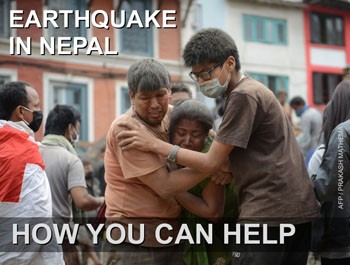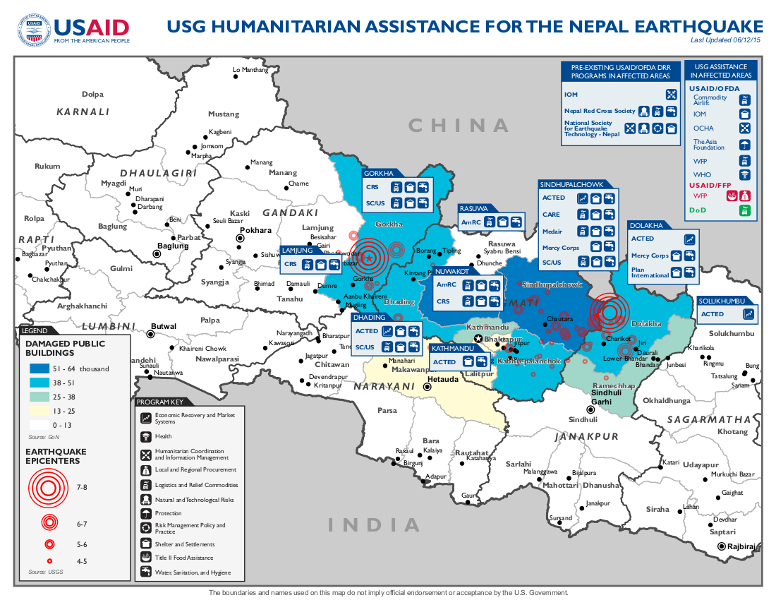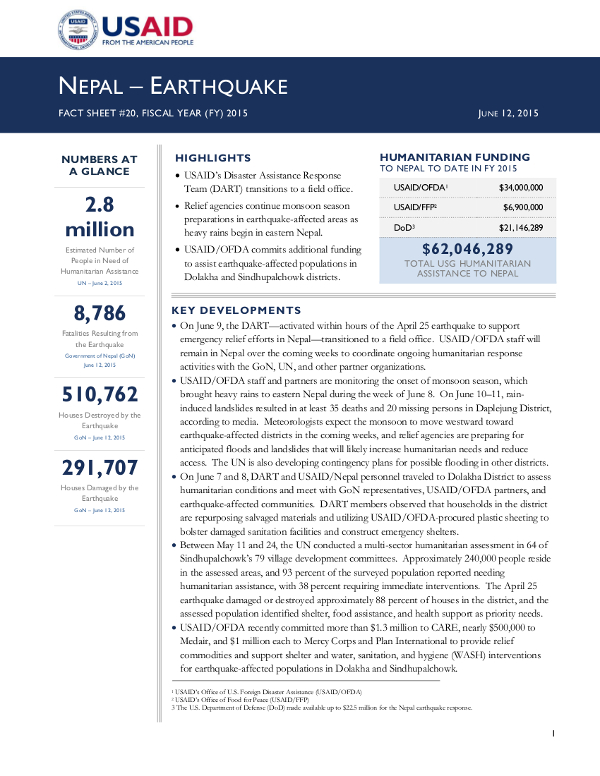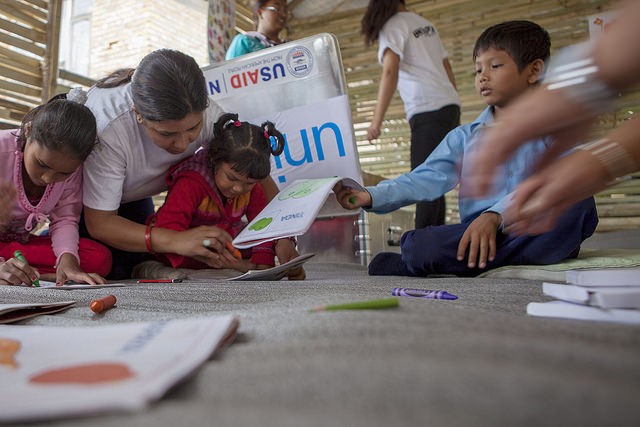Speeches Shim
June 12, 2015
Highlights
USAID’s Disaster Assistance Response Team (DART) transitions to a field office.
Relief agencies continue monsoon season preparations in earthquake-affected areas as heavy rains begin in eastern Nepal.
USAID/OFDA commits additional funding to assist earthquake-affected populations in Dolakha and Sindhupalchowk districts.
Key Developments
On June 9, the DART—activated within hours of the April 25 earthquake to support emergency relief efforts in Nepal—transitioned to a field office. USAID/OFDA staff will remain in Nepal over the coming weeks to coordinate ongoing humanitarian response activities with the GoN, UN, and other partner organizations.
Nepal Map - 06-20-2015 ![]() (pdf - 974k)
(pdf - 974k)
Numbers At A Glance
2.8 million
8,786
510,762
291,707
Humanitarian Funding:
To Nepal To Date In FY2015:
| USAID/OFDA | $34,000,000 |
| USAID/FFP | $6,900,000 |
| DoD | $21,146,289 |
| TOTAL | $62,046,289 |
Nepal Earthquake Fact Sheet #20 - 06-12-2015 ![]() (pdf - 201k)
(pdf - 201k)
USAID/OFDA staff and partners are monitoring the onset of monsoon season, which brought heavy rains to eastern Nepal during the week of June 8. On June 10–11, rain-induced landslides resulted in at least 35 deaths and 20 missing persons in Daplejung District, according to media. Meteorologists expect the monsoon to move westward toward earthquake-affected districts in the coming weeks, and relief agencies are preparing for anticipated floods and landslides that will likely increase humanitarian needs and reduce access. The UN is also developing contingency plans for possible flooding in other districts.
On June 7 and 8, DART and USAID/Nepal personnel traveled to Dolakha District to assess humanitarian conditions and meet with GoN representatives, USAID/OFDA partners, and earthquake-affected communities. DART members observed that households in the district are repurposing salvaged materials and utilizing USAID/OFDA-procured plastic sheeting to bolster damaged sanitation facilities and construct emergency shelters.
Between May 11 and 24, the UN conducted a multi-sector humanitarian assessment in 64 of Sindhupalchowk’s 79 village development committees. Approximately 240,000 people reside in the assessed areas, and 93 percent of the surveyed population reported needing humanitarian assistance, with 38 percent requiring immediate interventions. The April 25 earthquake damaged or destroyed approximately 88 percent of houses in the district, and the assessed population identified shelter, food assistance, and health support as priority needs.
USAID/OFDA recently committed more than $1.3 million to CARE, nearly $500,000 to Medair, and $1 million each to Mercy Corps and Plan International to provide relief commodities and support shelter and water, sanitation, and hygiene (WASH) interventions for earthquake-affected populations in Dolakha and Sindhupalchowk.
DISPLACEMENT AND SHELTER
The April 25 earthquake and aftershocks have damaged or destroyed nearly 802,500 houses, according to the GoN. USAID/OFDA partner the International Organization for Migration (IOM) recently reported increased population movements from the most-affected rural areas to displacement sites in the Kathmandu Valley, with approximately 127,500 people sheltering in displacement sites across Nepal as of June 6.
As of June 10, IOM had provided approximately 40,000 families with shelter assistance and emergency relief commodities; the organization plans to support up to 60,000 additional households in the coming weeks. Through a cash-for-work program in Sindhulpalchowk’s Chautara Municipality, IOM has also supported the removal of approximately 10,500 cubic meters of debris—improving safety and providing essential employment income. With $2 million in USAID/OFDA support, IOM continues to gather, analyze, and disseminate information on the number and condition of displaced persons, develop targeted response strategies, and deliver shelter supplies to populations in need.
To date, USAID/OFDA has provided nearly $6 million to eight partners to support shelter interventions across earthquake-affected districts in Nepal.
LOGISTICS AND RELIEF COMMODITIES
Humanitarian organizations continue to address pressing logistical concerns, such as restricted access to remote communities, in advance of the monsoon rains. As of June 10, the Logistics Cluster—the coordinating body for humanitarian logistics activities, comprising UN agencies, non-governmental organizations, and other stakeholders— reported working with 94 organizations to coordinate the delivery of more than 5,600 metric tons (MT) of relief items to earthquake-affected populations. The UN Humanitarian Air Service in Nepal reports providing services to 50 humanitarian partners in 87 locations, completing more than 830 flights and transporting more than 400 MT of emergency relief materials since April 29.
To date, USAID/OFDA has provided humanitarian partners nearly $10 million to strengthen logistics capacity and provide relief commodities to earthquake-affected families in Dhading, Gorkha, Lamjung, Nuwakot, Rasuwa, and Sindhupalchowk districts. USAID/OFDA assistance includes $3 million to the UN World Food Program (WFP)—the head of the Logistics Cluster—to coordinate and manage logistics activities to ensure the timely delivery of relief supplies.
WFP and other USAID/OFDA partners are working with mountaineers and Nepal’s porter network to deliver humanitarian assistance to 82,000 people in areas inaccessible by road or air and restore trail networks in advance of monsoon season.
WASH
The WASH Cluster estimates that approximately $1.1 million people do not have access to reliable water supplies or sanitation facilities due to earthquake damage, and relief agencies expect the impending monsoon season to result in additional damage to water systems and increased humanitarian needs.
As of June 2, WASH Cluster partners reported reaching more than 960,000 people with emergency water interventions and approximately 10,700 people with sustained water interventions. Cluster partners also provided approximately 43,300 people with access to sanitation facilities and nearly 288,000 with hygiene kits.
To date, USAID/OFDA has provided more than $2.7 million to implementing partners to support WASH interventions in Dhading, Dolakah, Gorkha, Kathmandu, Lamjung, Nuwakot, Rasuwa, and Sindhupalchowk districts. USAID/OFDA partner activities include conducting hygiene promotion activities, repairing water supply infrastructure, assisting with the construction of temporary emergency latrines, and providing safe drinking water and essential WASH supplies.
HEALTH AND PROTECTION
In Nepal’s 14 most-affected districts, the April 25 earthquake and aftershocks have damaged more than 1,000 health facilities and affected access to health care services for nearly 5.1 million people, according to the Health Cluster. Relief agencies are working to increase access to health services in earthquake-affected areas, including access to reproductive and mental health services.
As of June 8, the UN Population Fund (UNFPA) had collaborated with the Adventist Development and Relief Agency, CARE, the Family Planning Association of Nepal, and other partners to support 50 mobile reproductive health camps in 14 districts, providing those most affected by the earthquake with antenatal and postnatal care, family planning and health information, and psychosocial counseling.
The UN Children’s Fund (UNICEF), in partnership with the Transcultural Psychosocial Organization Nepal, has deployed 28 counselors to 14 districts, helping more than 3,450 children and adults address the emotional toll of the earthquake. UNICEF has also supported the establishment of 132 child-friendly spaces in 13 of the 14 districts most affected by the earthquake, providing an estimated 12,600 vulnerable children with safe environments in which to play.
The humanitarian community and Nepalese authorities have expressed concern over the increased vulnerability of children to child trafficking following the April 25 earthquake. In response, UNICEF is working with the GoN Ministry of Home Affairs and Nepal Police to assist 84 police stations and checkpoints in preventing child trafficking, and has contributed to the interception of 95 child trafficking instances as of June 11.
Since 2010, the USAID-funded Combating Trafficking in Persons (CTIP) program, implemented by The Asia Foundation, has worked with GoN stakeholders to combat trafficking and address the vulnerabilities of marginalized groups in Nepal, including survivors of human trafficking and gender-based violence (GBV). USAID/OFDA recently provided $450,000 to support the CTIP program and enable The Asia Foundation to expand operations to six earthquake-affected districts—Dhading, Dolakha, Lalitpur, Nuwakot, Ramechhap, and Rasuwa—where it will provide psychosocial support and help mitigate the increased risks of trafficking and GBV associated with earthquake-related economic instability.
INTERNATIONAL ASSISTANCE
As of June 11, the USG had provided more than $62 million for earthquake response and recovery efforts in Nepal, while other international donors had provided nearly $281 million. Of the total international assistance, approximately $129 million has supported the current UN flash appeal—31 percent of the $422 million requested.
CONTEXT
On April 25, a magnitude 7.8 earthquake struck central Nepal’s Gorkha District, approximately 77 kilometers (km) northwest of Kathmandu, at a shallow depth of approximately 15 km, according to the U.S. Geological Survey (USGS).
The USG immediately issued a disaster declaration for Nepal due to the effects of the earthquake. Within hours of the seismic event, USAID/OFDA activated a Response Management Team (RMT) in Washington, D.C., and deployed a Disaster Assistance Response Team (DART)—including urban search-and-rescue (USAR) specialists—to Nepal.
On May 12, a magnitude 7.3 aftershock struck Nepal’s Dolakha District, approximately 76 km northeast of Kathmandu, according to USGS. The aftershock caused further casualties and damage in areas affected by the April 25 earthquake.
For nearly two decades, USAID/OFDA has supported disaster risk reduction (DRR) efforts in Nepal, including throughout Kathmandu Valley. USAID/OFDA funding has enabled partners to identify, prepare, and preserve more than 80 open spaces in Kathmandu Valley for humanitarian purposes; pre-position critical emergency relief supplies; and strengthen earthquake response capacity at the local and national levels in collaboration with the GoN, nongovernmental organizations, private companies, and local communities. More information on USAID/OFDA’s DRR programs in Nepal and throughout South Asia is available at www.usaid.gov/what-we-do/working-crises-andconflict/disaster-risk-reduct....
PUBLIC DONATION INFORMATION
The most effective way people can assist relief efforts is by making cash contributions to humanitarian organizations that are conducting relief operations. A list of humanitarian organizations that are accepting cash donations for disaster responses around the world can be found at www.interaction.org.
USAID encourages cash donations because they allow aid professionals to procure the exact items needed (often in the affected region); reduce the burden on scarce resources (such as transportation routes, staff time, and warehouse space); can be transferred very quickly and without transportation costs; support the economy of the disaster-stricken region; and ensure culturally, dietary, and environmentally appropriate assistance.
More information can be found at:
- The Center for International Disaster Information: www.cidi.org or +1.202.821.1999.
-
Information on relief activities of the humanitarian community can be found at www.reliefweb.int.





Comment
Make a general inquiry or suggest an improvement.